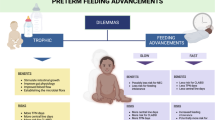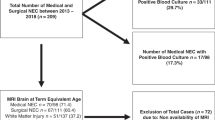Abstract
Background/Objective:
In this retrospective study, we intended to test whether early enteral feeding (EEF) of very low birth weight (VLBW) preterm babies increases the risk of necrotizing enterocolitis (NEC) or not.
Subjects and Methods:
Overall, 297 VLBW preterm babies admitted to the neonatal intensive care unit (NICU) between April 2003 and April 2006 were included. The study consisted of two periods: the first period was between April 2003 and October 2004, when babies were not fed enterally until they were extubated (167 preterm VLBWs). The second period was between November 2004 and April 2006, when babies were fed even when they were intubated, starting preferably on the first day of life (130 preterm VLBWs). Criteria for withholding enteral feeding in both periods were hypotension necessitating vasopressor agent use, abdominal distention, abdominal tenderness and suspected or proven NEC. Possible risk factors for NEC were also recorded.
Results:
The overall incidence of NEC in VLBW preterm babies was 6.7% and did not differ between the two study periods: 7.2% in the late and 6.2% in the EEF regimens. On logistic regression analysis, the most important risk factors associated with NEC were sepsis (P<0.001) and blood culture positivity (P<0.001). The average daily weight gain was significantly higher in the early fed babies (P=0.011).
Conclusions:
The EEF of VLBW preterm babies does not increase the risk of NEC. Increased daily weight gain is an important reason to feed these babies earlier.
This is a preview of subscription content, access via your institution
Access options
Subscribe to this journal
Receive 12 print issues and online access
$259.00 per year
only $21.58 per issue
Buy this article
- Purchase on Springer Link
- Instant access to full article PDF
Prices may be subject to local taxes which are calculated during checkout
Similar content being viewed by others
References
Davey AM, Wagner CL, Cox C, Kendig JW (1994). Feeding premature infants while low umbilical artery catheters are in place: a prospective, randomized trial. J Pediatr 124, 795–799.
De Silva A, Jones PW, Spencer SA (2004). Does human milk reduce infection rates in preterm infants? A systematic review. Arch Dis Child Fetal Neonatal Ed 89, F509–F513.
Ehrenkranz RA, Dusick AM, Vohr BR, Wright LL, Wrage LA, Poole WK (2006). Growth in the neonatal intensive care unit influences neurodevelopmental and growth outcomes of extremely low birth weight infants. Pediatrics 117, 1253–1261.
Flidel-Rimon O, Friedman S, Lev E, Juster-Reicher A, Amitay M, Shinwell ES (2004). Early enteral feeding and nosocomial sepsis in very low birth weight infants. Arch Dis Child FNE 89, F289–F292.
Guillet R, Stoll BJ, Cotten CM, Gantz M, McDonald S, Poole WK et al. (2006). National Institute of Child Health and Human Development Neonatal Research Network. Association of H2-blocker therapy and higher incidence of necrotizing enterocolitis in very low birth weight infants. Pediatrics 117, 137–142.
Hughes CA, Doweling RH (1980). Speed of onset of adaptive mucosal hypoplasia and hypofunction in the intestine of parenterally fed rats. Clin Sci 59, 317–327.
Khayata S, Gutcher G, Bamberger J (1987). Early versus late feeding of low birth weight (LBW) infants: effect on growth and hyperbilirubinemia. Pediatr Res 21, 431A.
Krediet TG, van Lelyveld N, Vijlbrief DC, Brouwers HA, Kramer WL, Fleer A et al. (2003). Microbiological factors associated with neonatal necrotizing enterocolitis: protective effect of early antibiotic treatment. Acta Paediatr 92, 1180–1182.
Lin PW, Stoll BJ (2006). Necrotizing enterocolitis. Lancet 368, 1271–1283.
McClure RJ (2001). Trophic feeding of the preterm infant. Acta Paediatr Suppl 90, 19–21.
McKeown RE, Marsh TD, Amarnath U, Garrison CZ, Addy CL, Thompson SJ et al. (1992). Role of delayed feeding and of feeding increments in necrotizing enterocolitis. J Pediatr 121, 764–770.
Moro ML, De Toni A, Stolfi I, Carrieri MP, Braga M, Zunin C (1996). Risk factors for nosocomial sepsis in newborn intensive and intermediate care units. Eur J Pediatr 155, 315–322.
Newell SJ (2000). Enteral feeding of the micropremie. Clin Perinatol 27, 221–234.
Pietz J, Achanti B, Lilien L, Stepka EC, Mehta SK (2007). Prevention of necrotizing enterocolitis in preterm infants: a 20-year experience. Pediatrics 119, e164–e170.
Puntis JW (2006). Nutritional support in the premature newborn. Postgrad Med J 82, 192–198.
Sakata H, Yoshika H, Fujita K (1985). Development of the intestinal flora in very low birth weight infants compared to normal full-term newborns. Eur J Pediatr 114, 186–190.
Sisk PM, Lovelady CA, Dillard RG, Gruber KJ, O'Shea TM (2007). Early human milk feeding is associated with a lower risk of necrotizing enterocolitis in very low birth weight infants. J Perinatol 27, 428–433.
Tollner U (1982). Early diagnosis of septicemia in the newborn. Clinical studies and sepsis score. Eur J Pediatr 138, 331–337.
Tyson JE, Kennedy KA (2005). Trophic feedings for parenterally fed infants. Cochrane Database Syst Rev 20, CD000504.
Tyson JE, Kennedy KA, Lucke JF, Pedroza C (2007). Dilemmas initiating enteral feedings in high risk infants: how can they be resolved? Semin Perinatol 31, 61–73.
Walsch MC, Klegman RM (1986). Necrotizing enterocolitis: treatment based on staging criteria. Pediatr Clin North Am 33, 179–201.
Ziegler EE, Thureen PJ, Carlson SJ (2002). Aggressive nutrition of the very low birth weight infant. Clin Perinatol 29, 224–225.
Acknowledgements
We thank Professor Şükrü Küçüködük, MD, for his support of all our scientific work and Eilon Shany, MD, for his encouragement on early enteral feeding.
Author information
Authors and Affiliations
Corresponding author
Rights and permissions
About this article
Cite this article
Çakmak Celik, F., Aygun, C. & Çetinoglu, E. Does early enteral feeding of very low birth weight infants increase the risk of necrotizing enterocolitis?. Eur J Clin Nutr 63, 580–584 (2009). https://doi.org/10.1038/sj.ejcn.1602957
Received:
Revised:
Accepted:
Published:
Issue Date:
DOI: https://doi.org/10.1038/sj.ejcn.1602957



